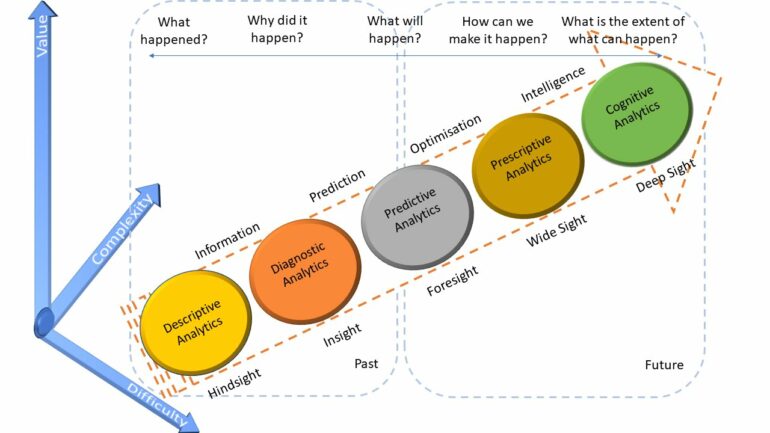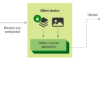In today’s data-driven world, data analytics has become a cornerstone of decision-making. However, despite the transformative potential, a significant number of analytics projects fail.
In a recent article published in Significance, we delved into the intricacies of data analytics, emphasizing the importance of problem-centric thinking in achieving successful outcomes.
A comprehensive analytics framework
Data analytics is a broad field involving data, tools and processes that include both computational and management processes to extract meaningful insights from processed data to make data-informed decisions. The challenges in data analytics are magnified in the era of big data, when datasets are voluminous, frequently updated and diverse in type and quality.
The image above depicts a comprehensive, orientation-driven framework. Built upon five types of analytics—descriptive, diagnostic, predictive, prescriptive and cognitive—this framework offers a unique lens through which we can navigate complexity, difficulty, and ultimately, value.
Complexity is equal to computational complexity, referring to the resources that algorithms consume (time and memory requirements). Difficulty stems from the intricacy of the problem being studied. Value is the ultimate outcome, encompassing better decision-making, improved performance and competitiveness, and organizational success, among others.
It should be noted that the various types of analytics, though presented in a sequence, are not mutually exclusive; they are interconnected and can operate concurrently based on the specific problem at hand. Furthermore, the visual representation of analytics in this manner reflects the notion that as analytics advance, increased complexity and difficulty should be introduced, requiring more resources—both computational and human. However, reality may differ, as there are instances where the implementation of more advanced analytics levels is not necessarily justified.
With so many options to choose from, it makes one wonder: why is having more data or sophisticated data analytics tools not a guarantor of success? There are many reasons why data analytics projects may fail. One reason is that actions are not necessarily taken based on the insights gained, as a result of inertia/management style, resistance, a lack of leadership support, internal politics, or an unwillingness to change. But the answer may also lie in the lack of a problem-centric thinking approach.
Understanding problem-centric thinking
Problem-centric thinking involves a deliberate shift in perspective, with the primary emphasis on identifying and solving real-world challenges. It encourages organizations to view data analytics not merely as a technological solution but as a means to address specific problems.
The essence of our argument lies in the importance of timely decision-making and bespoke analytics solutions tailored to specific problems. It’s not about drowning in an ocean of data or wielding the most advanced tools; it’s about an in-depth understanding of the problem and the strategic deployment of computational resources. By embracing this approach, we can shift the paradigm from high failure rates to a landscape where data analytics projects thrive and deliver tangible value. The future of analytics is problem-centric.
The benefits are plenty. In adopting a problem-centric thinking approach, organizations can foster a culture of continuous improvement. Rather than viewing challenges as obstacles, they become opportunities for innovation and growth. This mindset encourages teams to actively seek out problems, analyze them rigorously, and implement targeted solutions.
The iterative nature of problem-centric thinking not only enhances the adaptability of analytics strategies but also promotes a proactive approach to addressing emerging issues. Ultimately, organizations that prioritize problem-centric analytics are better positioned to navigate the complexities of an ever-evolving business landscape and achieve sustainable success.
The power of cognitive analytics
It is also relevant to note that the future of data analytics is poised to be revolutionized by the rise of cognitive analytics. As technology continues to advance, traditional data analytics methods are giving way to more sophisticated approaches that mimic human cognitive functions. To achieve this level of sophistication, cognitive analytics enlists the help of artificial intelligence, machine learning algorithms (specifically, reinforcement learning), semantics, game theory, and deep learning models.
By leveraging cognitive analytics, businesses can uncover hidden patterns, understand complex relationships, and make more informed decisions in real-time. This evolution represents a quantum leap in the capabilities of data analytics, “pushing” organizations toward a future where data is not just analyzed but comprehensively understood and strategically applied.
As organizations seek to derive greater value from their data, cognitive analytics emerges as a beacon of innovation, pushing the boundaries of what’s possible. It’s like exploring the uncharted territories of the mind of data.
Cognitive analytics is not just about crunching numbers; it’s about answering a more profound question: “What is the extent of what can happen?” It’s about gaining “deep sight” into the data, peeling back layers to reveal hidden patterns that might otherwise elude us. Imagine it as a quest to replicate human thought, to mimic the intricate workings of our very own brains.
Conclusion
As the data analytics field continues to evolve, problem-centric thinking will remain a guiding principle for organizations seeking to fully leverage the power of their data. Within this dynamic landscape, it becomes evident that each type of analytics offers a unique value proposition, and that one size does not fit all in the realm of analytics. The key, therefore, is to align the analytics approach with the specific problem at hand.
Moreover, delving into the realm of cognitive analytics amplifies the innovative potential, utilizing advanced technologies to replicate human thought processes and unlock unprecedented insights. Ultimately, the emphasis lies in recognizing that the future of analytics hinges on problem-centricity and the integration of cutting-edge cognitive analytics. This combination offers a sophisticated pathway to sustainable success in an ever-evolving business environment.
This story is part of Science X Dialog, where researchers can report findings from their published research articles. Visit this page for information about ScienceX Dialog and how to participate.
More information:
Vincent Charles et al, Why Data Analytics is an Art, Significance (2022). DOI: 10.1111/1740-9713.01707
Vincent Charles, PhD, PDRF, FRSS, FBCS, FHEA, MIScT, CMBE, is a Reader at Queen’s Business School, Queen’s University Belfast, and he holds multiple visiting professorship positions across the globe. His area of expertise lies in the fields of Artificial Intelligence and Management Science, with a particular focus on boosting business productivity, fostering regional competitiveness, and enhancing societal welfare, and a well-rounded commitment to driving positive multi-dimensional impact. He has proven academic experience in the HE sector, with more than a decade of full professorship, and he supports companies to enhance productivity via Predictive, Prescriptive, & Cognitive Analytics.
Citation:
Navigating the analytics frontier: Problem-centric thinking and the cognitive revolution (2023, December 11)



